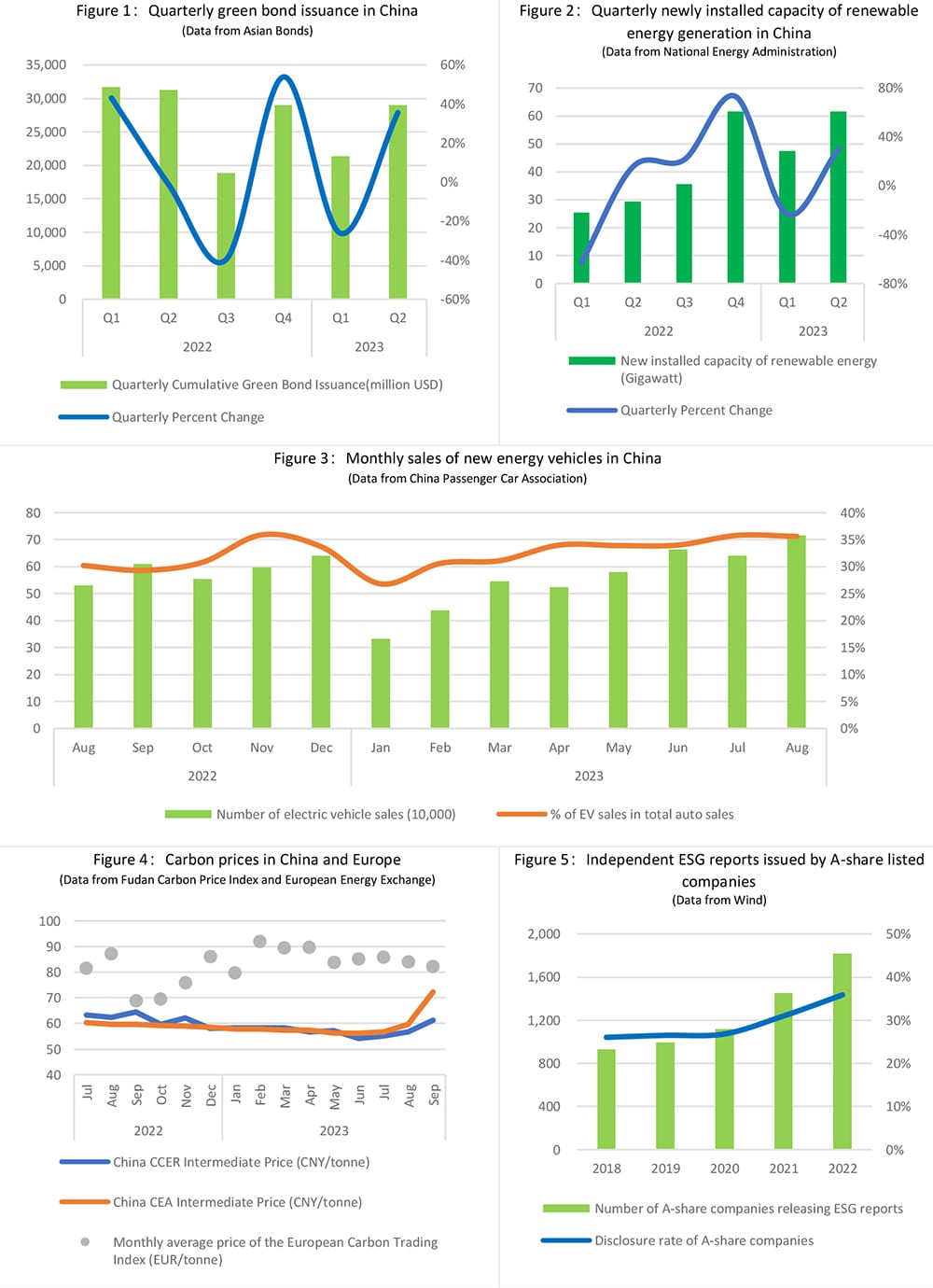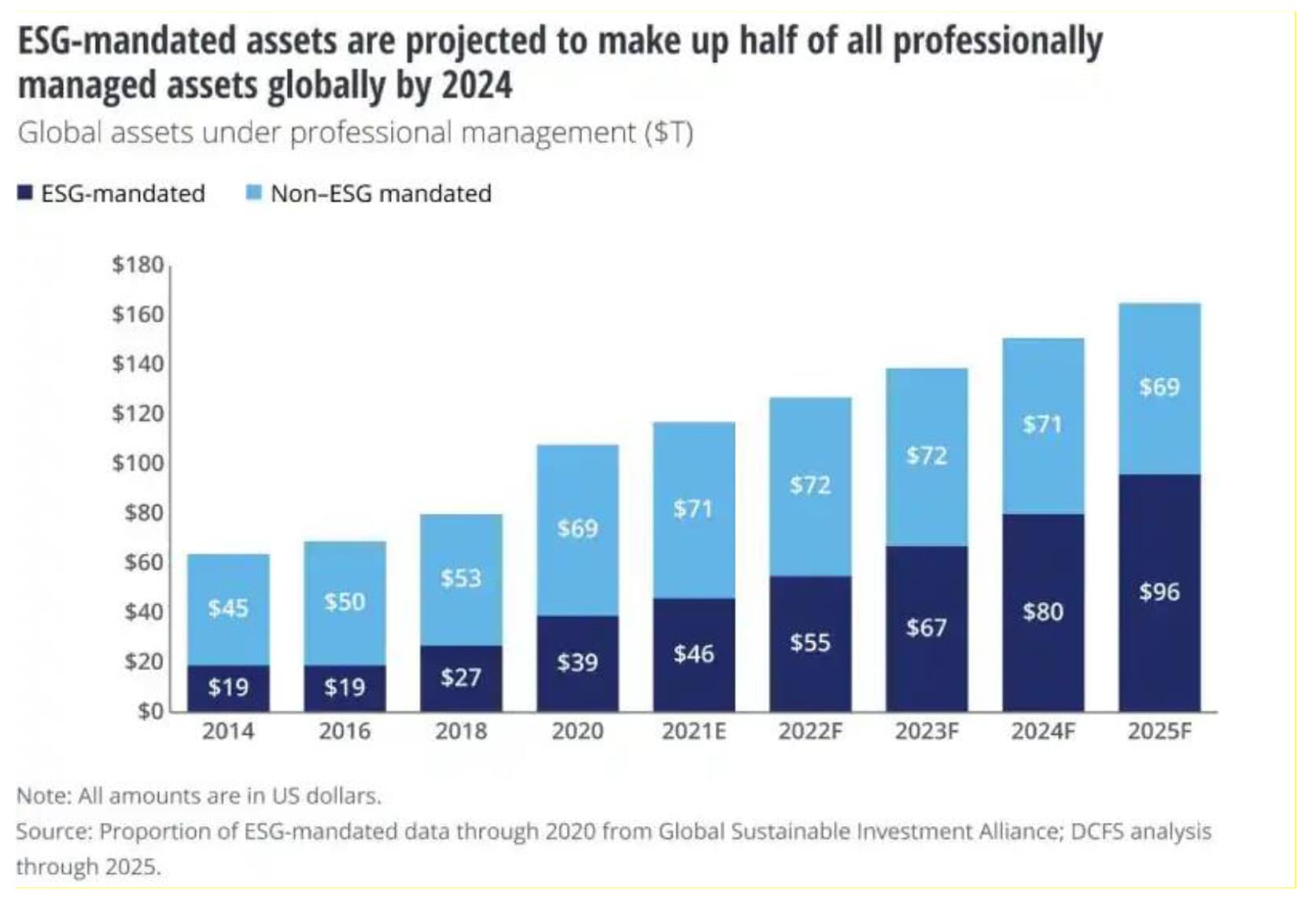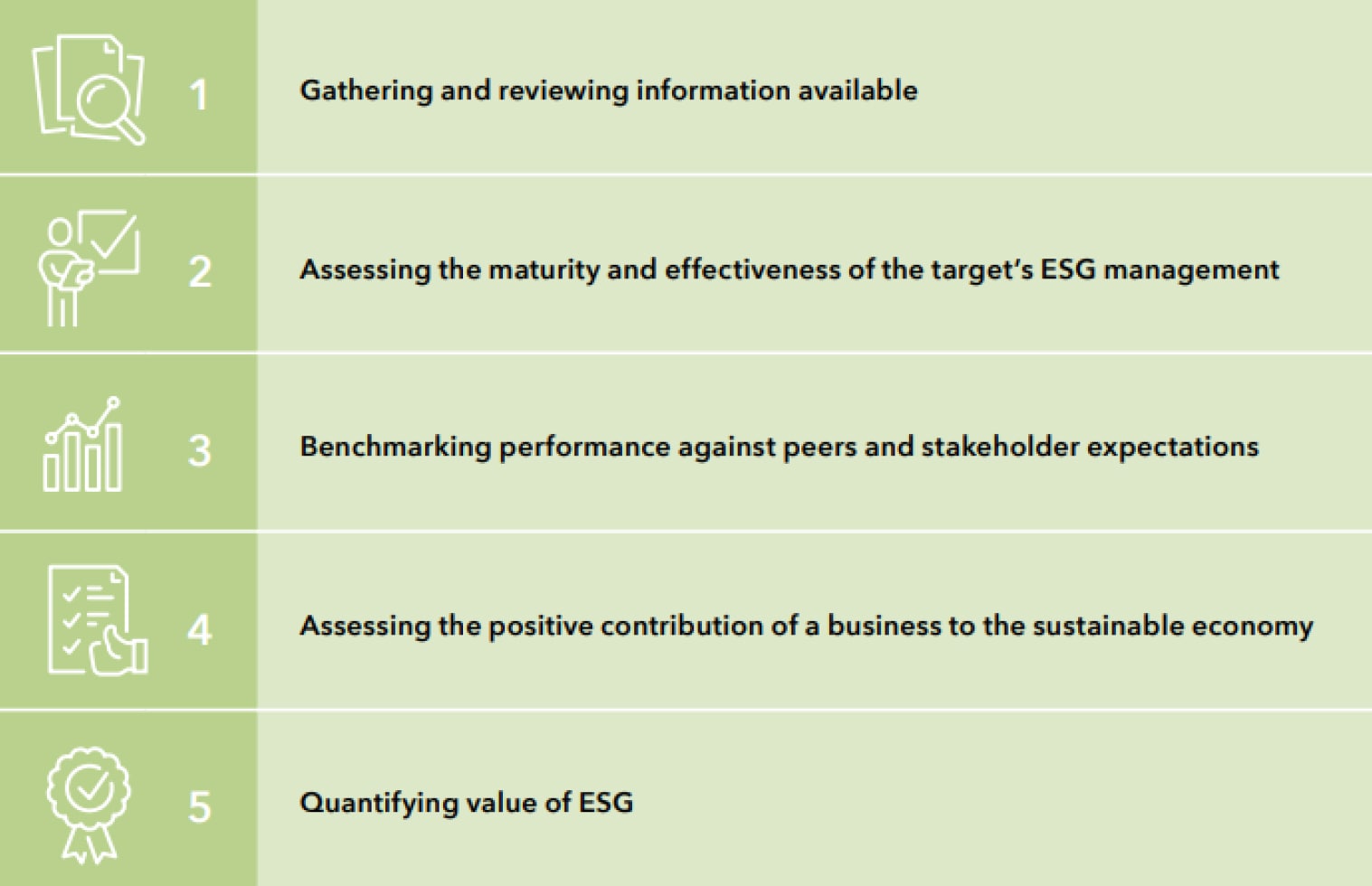Article
Sustainability Quarterly
Issue 4th
Published date: 17 October 2023
Explore Content
Welcome to the latest issue of Deloitte China's "Sustainability Quarterly." In this issue, we introduce a new section titled "Data Insights" , in which we delved into China's on-going exploration and recent advancement in realm of sustainability, examining various aspects tied to sustainable development. We have selected indicators such as green bond issuance, sales of new energy vehicles, and installed capacity of renewable energy generation to provide a comprehensive analysis of China's progress in sustainability-related domains.
In our “Topic of Focus”, we shine a spotlight on the launch of the first two sets of international sustainability disclosure standards by the International Sustainability Standards Board (ISSB). We analyse the new disclosure requirements, discuss their significance and impact, and provide recommendations for businesses to effectively handle sustainability information disclosure. This milestone is expected to further promote the establishment of consistent and comparable global sustainability disclosures.
Our "Managerial Perspective" section focuses on the development of China's private economy. Deloitte China has conducted in-depth research on the management best practices of leading private enterprises in China. Through surveys and extensive discussions with business leaders, we have identified key success factors for award-winning enterprises and outlined the main challenges they currently encounter. This information is valuable for Chinese companies striving to attain global excellence.
In the "Industry Frontier" section, we explore important areas of sustainable development. We analyse the prospects of the global green hydrogen market, explore the challenges and opportunities within sustainability landscape of the automotive industry, and track the market growth patterns in ESG investments.
The "Practice Innovations" section focuses on ESG considerations in merger and acquisition (M&A) strategies and the assessment of the importance of ESG in M&A transactions. We provide valuable insights and solutions for better integrating ESG into M&A investments, empowering companies to rapidly implement ESG principles and achieve sustainable development in a rapidly changing market.
We expect this issue of Sustainability Quarterly provides valuable insights for you, and join us in shaping a more sustainable future.
Li, Lily Xiao Chen
Deloitte China
Sustainability & Climate Leader
Data Insights |
|
Topic of Focus |
|
Management Perspective |
|
Industry Frontier |
|
Practice Innovations |
|
Data Insights |
In this issue, Data Insights examines China's proactive exploration and recent progress in the field of sustainable development through multiple dimensions, including green finance and investment, sustainable industries, carbon trading markets, and ESG disclosure. We have chosen five key indicators: green bond issuance, sales of new energy vehicles, installed capacity of renewable energy generation, domestic and international carbon trading prices, and the number of independent ESG reports published by A-share listed companies for a comprehensive analysis.

Green Bonds: Policies were introduced to improve the standard system of green bonds and foster the high-quality development of the green bond market
Chinese government strongly supports the development of green finance. The domestic green bond market shows a fluctuating upward trend. With the successive introduction of the "Catalog of Green Bond Support Projects (2021 Edition)" and the "China Green Bond Principles" , the domestic green bond assessment and certification system is gradually maturing. This encourages more funding to support green industries and projects.
In March 2023, the Shanghai Stock Exchanged issued the “Shanghai Stock Exchange Corporate Bond Issuance and Listing Review Guidelines No.2 – Specific Types of Corporate Bonds (Revision in 2023)”. This expanded the market for application of green bounds while imposing stricter requirements on the use of funds raised through green bonds.
In the first half of the year, several banks, including Industrial Bank, Bank of Communications, Shanghai Pudong Development Bank, and Bank of China, issued green bonds ranging from CNY 30 to 50 billion. In the second quarter of 2023, China's green bond issuance reached approximately USD 30 billion, marking a significant increase of about 36% compared to the previous quarter, essentially returning to the levels seen in the same period last year.
Renewable Energy: The installed capacity of renewable energy has steadily increased and now dominates the country's new power generation capacity
With a focus on ensuring energy supply and driving clean and low-carbon transformation, the national capacity and electricity generation from renewable energy sources have been consistently growing. In 2022, the newly installed capacity of renewable energy reached an impressive 152GW, accounting for 76.2% of the total new power generation capacity in the country. Renewable energy has become the main part of China's newly installed power capacity. In the first half of 2023, China added 109GW of renewable energy generation capacity, making up 77% of the total new capacity, with the second quarter seeing over 60GW added, marking a return to record highs.
New Energy Vehicles: The penetration rate of new energy vehicles (NEVs) in China is on the rise, with automakers accelerating overseas factory expansion.
According to the latest data from the China Association of Automobile Manufacturers, NEV sales in China reached 716,000 units in August, accounting for 35.8% of total automobile sales, a 5.6% increase compared to the same period last year. Additionally, NEVs are emerging as a substantial contributor to China's overall automobile exports, with the share of NEV exports increasing from 7% in 2020 to 21.8% in 2022.
However, some countries have implemented policies such as higher tariffs and subsidy restrictions to protect their domestic industries, which have curtailed China's NEV exports. To bolster their global competitiveness, several automakers, including Great Wall, BYD, XPeng, and NIO, are pursuing cross-border mergers and acquisitions, establishing production bases, setting up R&D centers, and expanding sales networks. During the first half of this year, Chery and SAIC announced plans to build factories in Argentina and Europe, respectively, as part of their strategies to further cultivate overseas markets.
Carbon Trading Market: The launch of the CCER (China Certified Emission Reduction) trading market is imminent and may affect the national carbon trading market price level
In July, the Ministry of Ecology and Environment, in conjunction with the State Administration for Market Regulation, revised the "Interim Measures for the Administration of Voluntary Greenhouse Gas Emission Reduction Trading Management," resulting in the formation of the "Interim Measures for the Administration of Voluntary Greenhouse Gas Emission Reduction Trading (Trial)," which is open to public feedback. This indicates the impending launch of the CCER trading market. With expectations of an expanded national carbon market and gradually tightening quotas, the existing demand for CCER has outstripped supply. This has led to a steady increase in national carbon prices since June, with prices reaching CNY 61.29 per ton for CEERs and CNY 72.23 per ton for CEA in September. However, China's carbon prices are still relatively low compared to the European Union's carbon market, where prices range from 70 to 90 euros per ton.
Sustainability Disclosure: ISSB's release of the first international Sustainable Disclosure Guidelines will further promote the ESG disclosure level of listed companies
The number of companies disclosing ESG information is increasing annually, driven by global climate change concerns, evolving regulatory policies, and the emergence of domestic and international ESG ratings. Over the past five years, the number of A-share listed companies disclosing ESG information has been steadily rising. By the end of 2022, over 1,800 A-share listed companies had published independent ESG reports, marking a significant year-on-year increase of 25%, with the disclosure rate rising from 26% in 2018 to 36%.
In July of this year, the State-Owned Assets Supervision and Administration Commission (SASAC) issued the guidelines on the preparation of Central SOEs’ ESG reports and standardized the framework for their ESG reports. This move further guides and regulates domestic ESG information disclosure standards.
With the ISSB officially releasing the final version of its first two sets of international financial reporting sustainability disclosure standards in June, more companies are expected to engage in sustainable information disclosure. This development paves the way for further development of consistent and comparable global sustainability disclosures.
Topic of Focus |
ISSB releases first international sustainability disclosure standards, marking a new era for sustainable information disclosure
Background
On June 26, 2023, the International Sustainability Standards Board (ISSB) officially released the final drafts of the first two International Financial Reporting Sustainability Disclosure Standards. These standards include the "International Financial Reporting Sustainability Disclosure Standard 1 - General Requirements for Sustainability-Related Financial Information Disclosure" (referred to as "S1" or "General Requirements Standard") and the "International Financial Reporting Sustainability Disclosure Standard 2 - Climate-Related Disclosures" (referred to as "S2" or "Climate Disclosure Standard"). This marks a historic breakthrough in global sustainable disclosure, paving the way for consistent and comparable global sustainability information disclosure.
Standard Content
S1 specifies the standard's objectives, scope, conceptual framework (including fair representation, materiality, reporting entity, and related information), and core contents. It also provides guidelines for general requirements (including guidance sources, data placement, , reporting period, comparative information, and compliance statements), as well as judgements, uncertainties, and errors. Deloitte recommends attention to the following aspects:
- Standard Objectives: S1 requires companies to provide information on sustainability-related risks and opportunities. This information aids decision-makers in determining resource allocation to businesses.
- Related Information: The relationships between different sustainability-related risks and opportunities, the relationships between disclosed core content (as detailed below), and the connections between financial statements and sustainability-related disclosure information.
- Core Contents: Companies should disclose critical sustainability-related information, which should encompass governance, strategy, risk management, metrics, and targets used to monitor, manage, address, and assess sustainability-related risks and opportunities.
- Guidance Sources: When identifying sustainability-related risks and opportunities and determining information (especially metrics) that falls outside of climate change disclosure, S1 specifies additional guidance resources that companies "need" and "are allowed" to refer to, , in addition to complying with- international sustainability disclosure standards. It also requires companies to disclose the references used.
- Comparable Information: If companies acquire new information related to disclosed metrics from the previous reporting period, and this new information provides evidence of changes from the previous period, companies should disclose revised comparable information for those metrics. They should also disclose the differences between revised metric values and the previous period's metric values, along with the reasons for the revisions.
- Business Sensitive Information: Under certain conditions, companies are allowed to exempt the disclosure of business-sensitive information related to sustainability opportunities. However, there are no exemption for disclosing information concerning sustainability risks.
- Other General Requirements: Reporting period; data placement.
S2 specifies the standard's objectives, scope, core contents, and more. Deloitte recommends focusing on the following aspects:
- Standard Objectives and Core Contents: Cross-industry indicators, including greenhouse gas emissions, the impacts of climate-related transition risks, the impacts of climate-related physical risks, the impacts of climate-related opportunities, related capital allocation, internal carbon pricing, and consideration of climate-related factors in executive compensation. Industry-specific indicators relevant to a specific industry's business model, activities, and characteristics (specific industry implementation guidance can be found in S2's accompanying documents). Company-set targets and indicators required by laws and regulations.
- Greenhouse Gas Emissions: Requires companies to disclose the total greenhouse gas emissions for Scope 1, Scope 2, and Scope 3 as measured under the Greenhouse Gas Protocol. Transitional and exempt measures have also been established.
- Financing Emissions: Requires companies engaged in commercial banking, insurance, and asset management (the three major categories of financial business) to disclose the total "financing emissions" (such as loans and investments), as part of Scope 3 greenhouse gas emissions, specifically under Category 15, "Investment." Detailed requirements have also been specified. Previously proposed requirements for "financing emissions" in investment banking and brokerage businesses (such as underwriting, asset securitization, and advisory services) are not mandatory at this stage due to the lack of a universally accepted measurement method.
- Using Climate Scenario Analysis to Assess Enterprise Climate Adaptation: Requires companies to use climate scenario analysis to assess their climate adaptation and disclose the results. Companies should select climate scenario analysis methods that match their specific circumstances for the reporting period (including the extent to which the company is affected by climate-related risks and opportunities, as well as the technological, capacity, and resource capabilities available for conducting climate-related scenario analysis).

Read the detailed report: Deloitte Sustainability Focus (Issue 58th)(Chinese)
Management Perspective |
China’s Best Managed Companies excel in globalization, innovation and resilient growth
As an international award program in China that offers a comprehensive assessment of private company management, the China Best Managed Companies (BMC) program utilizes the proven Deloitte global framework of Best Managed criteria, encompassing strategy, capabilities, commitment, and financial strength. It conducts a comprehensive selection process, recognizing and showcasing numerous private companies with promising future competitiveness, and bringing together excellent enterprise models in China.
The whitepaper on China Best Managed Companies has been published for five consecutive years and has become an in-depth research report summarizing the best practices of private enterprises operation and management. Key findings:
The newly awarded companies have demonstrated outstanding performance in globalization innovation. The gold award-winning companies have shown remarkable resilience in maintaining growth through the cycles.
In last year's research, leading private companies have already achieved certain results in areas such as digitalization, risk management and talent empowerment, etc. Based on this year’s research findings, Deloitte summarizes the key to success for BMC companies:
- Outstanding agility in adapting strategies and business models with a customer-centric focus.
- Casting innovative technical barriers and laying out a global and resilient supply chain.
- Taking responsibilities for social concerns and upholding values that aim to transform their respective industries.
- Demonstrating excellence in financial and tax management to support global and multi-channel expansion.
Survey results
【Strategy】
1. Core competitiveness revolves around agile innovation that address customer needs.
The distinctive core values, strategic objectives, and exceptional ability to integrate value with a customer-centric approach are the hidden keys to corporate success. The mastery of essential and core technologies with independent intellectual property rights has gained greater prominence this year, underscoring the pivotal role of technology excellence.
2. Enterprises faces several primary challenges, including diversifying innovation approaches, enhancing customer insights and interactions at the front end, strengthening the technology moat in the middle tier, and upgrading digitalization and intelligence of the organization and processes in the back end.
Last year, the top three challenges within the research enterprises were: designing an organizational model that effectively supports the rapid business expansion, cost management, , and upgrading R&D. This year, the primary challenges encompass designing an organizational model to effectively support the rapid business development, monitoring innovation and effectiveness in customer management and marketing management, and further R&D enhancement. All efforts to address the three challenges need to accelerate the application of digital intelligence.
【Capabilities】
3. The core of science, technology, and innovation (STI) lies in technological advancement driven by customer demand and cost reduction.
The research results show that in the next 2 years, the average planned research investment of BMC enterprises is 8.8%, much higher than the R&D intensity of 1.8% of China's top 500 enterprises in 2022. The focus of investment for leading private companies' investment in the realm of STI are as follows: firstly, technological upgrade driven by customer demand; secondly, the implementation of intelligence and digitalization; and thirdly, cost reduction initiatives.
4. Operating on a global scale not only brings about a flexible and resilient supply chain but also enhances the organization’s agility, , resulting in valuable feedback loops that improve management maturity.
The research results indicate that 1/3 of the BMC award recipients have a substantial presence of international business presence, accounting for an average of 24% of their total revenue. However, the private enterprises still need to improve their global operational capabilities. This includes maintaining a cost-effective and highly efficient overseas operating model, strengthening international brand development, and enhancing the intelligence and transparency of global compliance and risk management. In addition, enterprises need to address supply chain management challenges associated with global operations, such as improving supply chain resilience, continuity, and forecast accuracy.

【Commitment】
5. Decentralized organizational structure accelerates the replication of accumulated common organizing capabilities while supporting diversified talent development.
The most significant internal challenge regarding organizational change are as follows: firstly, unclear requirements for cross-organizational capabilities; secondly, a lack of agility in adpting to organizational transformation; and thirdly, the absence of clear execution rules for building high-performing teams. Agile organizations operating globally adopt a "decentralized" approach, where management platforms empowering teams with full authority to replicate common organizational capability that have been developed. This results in business units forming clear, flexible structures with appropriate granularity. The main challenge in enterprise talent development stems from the profound changes brought by technological and social shifts in talent recruitment, cultivation, incentives, leadership development, and succession planning. The long-term development of key talents and fostering workplace diversity remain the main challenges.
6. New products and services aligned with carbon peaking and carbon neutrality goals are growing rapidly, but challenges persist in building sustainable supply chains.
The findings show that nearly 50% of BMC companies have developed numerous climate andenvironmentally friendly technologies, products, and services over the past five years. However, challenges persist in building sustainable supply chains. Nearly 50% of the companies indicated that they would increase financial investment in relevant strategies, technologies, products or services aligned- with carbon peaking and carbon neutrality goals. They plan to deploy climate change strategies in the future to drive growth along the third and fourth growth curves.
【Financial Strength】
7. Strengthen the pooling of capital and ensure financial resilience.
Throughout the epidemic cycle, BMC winners responded to capital risk by strengthening liquidity management and improving internal operational efficiency. They also reinforced their overall capital integration, ensuring a financial resilience and sufficient liquidity.
8. The financial digital transformation emphasizes data governance
The greatest challenges faced by the finance department in driving digitization include two key aspects. Firstly, data governance remains a significant hurdle with enterprise feedback data quality being partially constrained by inconsistent standards, making it challenging to effectively support unified data management and analysis. Secondly, system fragmentation persists, resulting in incomplete information across different systems and the presence of information silos. The focus of future upgrade will continue to focus on enhancing data governance.

Read the detailed report: Whitepaper on China Best Managed Companies (Chinese)
Overcoming the hurdles to integrating sustainability into business strategy
In the face of escalating climate change risks, companies are starting to align themselves with a more sustainable world. However, why hasn't more progress been made to help address climate change?In a word, uncertainty. Few business leaders have experienced this level of change before and it's taking place at a time of tremendous disruption—the Russia-Ukraine war, the energy crisis, geopolitical tensions, rapidly changing technologies, supply shortages, and the lingering effects of the COVID-19 pandemic.
Leaders are facing integration challenges on all levels
- Perceived lack of clear direction. Deloitte's research suggests that some companies have held back on making investments because they were waiting to see where climate policies and regulation would ultimately land. In some jurisdictions, there has even been some entrenched scepticism that governments will follow through on climate action: Only 28% of the executive leaders surveyed by Deloitte said that governments around the world are "very serious" about it.
- Feeling stuck between conflicting expectations. The intense external interest in a company's environmental, social and governance performance often results in overlapping information requests, which compete for limited resources, and raise questions about how to prioritize efforts when the audience and benefits are not always clear.
- Overwhelm and decision fatigue. Leaders are not motivated to explore the potential business opportunities of the transformation the different sectors are in, and prioritize short-term security over long-term investments, but in fact, further climate delay comes at a great cost.
The problems we face require business transformation
- Know thy self. Invest in data quality and identify the material risks that align to purpose.
- Root goals in strong governance. Embedding sustainability into business operations requires accountability.
- Chart your own course. Organizations can find traction through authentic stakeholder dialogue about what the future holds and where a company is on the sustainability journey.
- Reframe the problems. Managing uncertainty requires business leaders to get comfortable with making decisions without a perfect answer.
- Commit together to a better future. No organization or institution can address the sustainability challenge by themselves.

Read the detailed report: Overcoming the hurdles to integrating sustainability into business strategy
Industry Frontier |
Green hydrogen: Energizing the path to net zero
Green hydrogen is becoming the key clean hydrogen supply option in the long run, being both economically viable and truly sustainable. It can lead to significant emission savings in hard-to-abate sectors: heavy industry (such as steelmaking and chemicals) and heavy transport (such as aviation and shipping). Moreover, if wind and solar power continue to expand, hydrogen can provide flexibility and network stability to the power systems.
Emerging green hydrogen market to redraw the global energy and resource map as early as 2030, creating a $1.4 trillion a year market by 2050.
Unleashing Opportunities
Deloitte's outlook, based on the Hydrogen Pathway Explorer (HyPE) model, explores the emergence of a carbon-neutral, inclusive green hydrogen economy in the coming years: from US$642 billion in annual revenue in 2030 to US$1.4 trillion per year in 2050, a recognized milestone to reach climate neutrality. This analysis reveals an opportunity for private and public leaders to accelerate the green energy transition and abate up to 85 GtCO2eq in cumulative emissions by 2050.
Global trade is key
Global trade is key to unlocking the full potential of the green hydrogen market, supported by diversified transport infrastructure. Deloitte's outlook shows that in 2050, global trade between major regions can generate more than US$280 billion in annual export revenues. The most common products are hydrogen derivatives—ammonia, methanol, and Sustainable Aviation Fuel (SAF)—which are easier to transport over long distances.
By 2050, the main recipients include North Africa (US$110 billion per year), North America (US$63 billion), Australia (US$39 billion), and the Middle East (US$20 billion).
Free and diversified trade can significantly reduce costs, improve energy security, and foster economic development in developing and emerging markets. Export revenues from green hydrogen can bring economic development opportunities to developing countries, and can, in part, offset declining revenue from oil, natural gas, and coal.
An investment worth making
Governments and companies should look to redirect spending on oil and gas to hydrogen. Deloitte's outlook estimates more than US$9 trillion of cumulative investments are required in the global green hydrogen supply chain to meet net-zero compliance by 2050, including US$3.1 trillion in developing economies. Though daunting, the investment broken down to an annual average are significantly less than the US$417 billion spent on oil and gas production in 2022 globally.
At the global scale, green hydrogen could support up to 2 million jobs per year between 2030 and 2050. The impacts are significant to environmental, economic, and social prosperity.
Future-focused policy and global co-operation
Decisive policy support is essential to help scale up the green hydrogen economy and ensure that, especially, green hydrogen plays its needed role on the path to climate neutrality.
Policymakers should focus attention on three components:
- Laying the foundations for a climate-oriented market.
- Creating a business case.
- Ensuring long-term resilience.

Read the detailed report: Green hydrogen: Energizing the path to net zero
Achieving sustainable development marks a new track for automobile enterprises to win
Automobile industry of China is experiencing rapid growth and global expansion. Sustainability servce as an important driving force for Chinese automobile enterprises to achieve high-quality development. In a world, where China, the European Union and many other countries and regions are actively promoting carbon neutrality, the automotive sector is currently at a strategic juncture.
Chinese automobile enterprises should embrace sustainable development as a core value, strengthen their governance capacity, and make positive impacts on the society and environment. This will not only enable them to create long-term value but also position them strategically in a rapidly evolving industry landscape.
Challenges faced by automobile companies in sustainable development
While many automobile companies have recognized the importance of sustainable development, progress in the industry has been somewhat limited. The proportion of automobile companies with comprehensive sustainable development strategies and clear goals has seen only a marginal increase. Response to key sustainability issues remains restrained, with over half of the automobile companies failing to develop an advantage in sustainable development strategy and implementation. Several factors contribute to these challenges:
Need for Improved Integration: a issue lies in the integration of sustainable development management into daily operations. Most automobile enterprises have yet to developed a clear sustainable development strategy that aligns with their business strategies. This lack of alignment results in undefined management responsibilities, unimplemented policies and systems, and a lack of integrated performance evaluation. Consequently, this impeding the implementation of sustainable development management and practice.
Limited Progress in Key Initiatives: Most automobile enterprises are still in the early stage of exploring and initiating carbon management. These initiatives are often subject to various industry-specific factors, including the energy structure, raw materials at the operational level. A "linked but not cooperative, cooperative but not effective" dynamic exists among enterprises at all ends and within various parts of the value chain. In addition, in the context of the global response to climate change, the connotation of ESG is easily understood to be related to the carbon reduction results, simplifying the broader sustainability perspective.
How automobile companies can gain a competitive advantage in sustainable development
Establishing and improving Sustainable Development Management System
At the level of strategic integration, Deloitte believes that automotive companies should identify the key factors of sustainable development that affect both financial and non-financial performance. They should assess their business strategy relevant to their development, and accordingly plan a sustainable vision, goals and a strategic roadmap that match the business strategy.
At level of the well-defined authority and responsibility, Deloitte recognizes that the extent to which the board and senior management involve in and put the emphasis on sustainability management has a direct impact on the outcomes of specific sustainability initiatives.
At the level of performance evaluation, Deloitte believes that automobile companies should formulate a practical performance evaluation system for sustainable development based on the company's sustainable development strategy.
In addition, the rapid growth in the globalization efforts of the Chinese automobile industry is evident. After years of cultivation, Chinese automobile enterprises have adopted the "tailoring to local conditions" approach including building overseas factories, procuring local components, and selling at the local market. Chinese automobile enterprises should continue to extend their global footprint and formulate market-entry and cultivating strategies tailored to their specific needs.
Keeping focus on key issues to cultivate sustainable competitiveness:
In the realm of product design and supply chain practices, the key strategies to reshape the competitiveness of automobile enterprises for the future involve commercializing and scaling up circular economy, upgrading green supply chain, forming clean energy chain, and promoting the materials recycling chain.
In terms of production and operation, manufacturing is a key area for carbon emission reduction. Automobile enterprises can improve energy efficiency in the production process through process upgrades, minimize waste through effective resources recycling, enhance the capacity of renewable energy by adopting clean energy such as solar and wind in their production bases, and achieve carbon neutrality in production and operation by procuring additional green energy through power purchase agreements and building green factories.
Give that automobile industry largely relies on technology, capital, and a skilled workforce, science, technology, and talent are crucial for maintaining competitiveness. Ensuring the well-being and rights of employees and implementing advanced management concept are important to the sustainable development of automobile companies. These enterprises should prioritize employee rights and interests, emphasize equality and inclusiveness, provide excellent welfare system, guarantee personal growth opportunities to create a more suitable platform for work and development. Establishing a fair, transparent, safe, and healthy work environment can enhance production efficiency and contribute to overall success.

Read the detailed report: Achieving sustainable development marks a new track for automobile enterprises to win (Chinese)
Ingraining sustainability in the next era of ESG investing
Key messages
- As regulators around the world continue to receive input from investors and move toward adopting ESG investing standards in their own jurisdictions, the debate is shifting from whether ESG investing is a niche to how investment managers should respond.
- At their current growth rate, ESG-mandated assets (defined here as professionally managed assets in which ESG issues are considered in selecting investments or shareholder resolutions are filed on ESG issues at publicly traded companies) are on track to represent half of all professionally managed assets globally by 2024.
- The majority of new ESG fund are expected to be in line with principles similar to Article 8, or in other words, with ESG characteristics playing a meaningful role in the investment decision-making process.
- Investment managers may alleviate concerns from regulators and investors by conducting a holistic review of ESG investing related disclosures and implementing related compliance policies consistently throughout the firm.
- Responsible digital transformation may provide a path forward to adopt sustainability initiatives and improve client engagement. More and more stakeholders are including societal impacts in addition to financial metrics when measuring the performance of financial institutions. In order to provide the data needed to perform this type of assessment, investment management firms may benefit from verification or assurance by an independent third party.


Read the detailed report: Ingraining sustainability in the next era of ESG investing
Practice Innovation |
Embracing the integrate of ESG into M&A
The Institute of Chartered Accountants in England and Wales (ICAEW) and Deloitte jointly released Whitepaper on ESG M&A Investment. The whitepaper starts from Why ESG matters, introduces different forms of ESG in M&A strategies and how to assess ESG with an M&A transaction, and provides valuable advice and solutions for better ESG integration in M&A investments.
ESG has become a key factor for stakeholders so investors and companies cannot afford to be misaligned with stakeholder values
The importance of ESG within a corporate environment has risen significantly in recent years. Many businesses are striving for a sustainable business strategy to cover ESG factors while also positively benefitting their shareholders.
ESG performance is a drive of both operating value and investor valuations
For several years there has been strong anecdotal evidence of ESG factors contributing to both value creation and destruction. This has come in the form of executive and investor surveys, and specific examples of ESG incidents that caused reputational damage and eroded shareholder value as a result. A Deloitte industry report showed a clear correlation, consistent across all sectors assessed, between a company's ESG rating and the valuation multiple.
ESG as a key factor in M&A strategy
ESG has become a significant aspect of a business's origination and M&A process in order to deliver long-term value for stakeholders, both as a driver of M&A deals and a core consideration within non-ESG focused transactions.
Defensive and offensive M&A strategies are typically applicable to corporate M&A and resulting acquisitions or disposals can be described as 'ESG Motivated' transactions. Private equity investors seeking to acquire businesses which deliver, or have the potential to deliver significant positive social and environmental impacts are also ESG Motivated. As described above, ESG Motivated transactions include companies using M&A as a catalyst to advance their ESG priorities and rapidly respond to transitioning markets. This may include acquiring new technologies, skills, or assets to enhance the ESG positioning, or a rebalancing of portfolios in the face of shifting markets to capitalise on growth areas and avoid stranded assets. Similarly, it includes where ESG is driving demand for companies that engage in sustainable activities.
Assessing ESG within an M&A transaction
A key question often asked by prospective investors is, 'What are the material ESG risks for this business? ' Effective diligence, evaluation, and management of ESG considerations within a transaction can help mitigate risks, improve financial performance, and accelerate growth. However, determining the impact of ESG factors on a target company is not straightforward. Some of the challenges in the context of an M&A transaction are explained below: lack of ESG awareness, lack of data and poor data quality, quantification of risks and opportunities, unrealistic target setting and business integration capacity.
Given the limited time and resources in diligence, it is hard to conduct a comprehensive assessment of all ESG topics. Hence, a methodology needs to be developed to effectively identify potential material issues.
Standard ESG diligence aims to address the challenges above and typically follows a similar approach to other diligence workstreams, as shown in Figure.
Figure: Example of ESG due diligence workstream

The spectrum of ESG factors' impact varies from compliance risk mitigation through gender and ethnic diversity, to new business model opportunities. Other ESG factors can be blended into profit margin or growth, or customer loyalty and retention and their identification and quantification depend on the existence of data points and benchmarks. As data availability improves and value becomes more explicitly linked to EBITDA performance and valuation multiples, it is possible to identify the financial lever which ESG could impact, and through analysis or proxies to estimate the quantum of such impact.
Post-transaction, investors need to ensure that management deliver ESG performance that works towards sustainability and value. Equally, the companies involved in the transaction need to manage a successful integration, particularly with regards to ESG strategy and commitments to optimise value. Developing a robust governance structure, integrating internal audit and the board of directors into such structure, and obtaining external assurance (ie, the three lines of defence) can enhance public trust and improve a company's ability to meet stakeholder expectations for the disclosure of accurate and reliable information. It can also reduce risks related to misleading or omitted disclosures. Implementing the three lines of defence will promote high-quality, relevant, and meaningful non-financial disclosures, enhance investors' reliance on reported information, permit better analysis of such information, and promote ESG investing.
Conclusion remarks
ESG and responsible investment considerations are profoundly reshaping business models. In the coming years, as stakeholder focus on ESG increases they will become even more intrinsically embedded across M&A. The approaches taken during the deal should reflect relevant frameworks, be backed by robust due diligence, and be carried out in a world of evolving expectations. ESG-assessed M&A will be an important means to create growth, a competitive edge, and access to affordable capital.
There are little conceivable way businesses can build a stable long-term future without ESG embedded throughout strategic processes, including their favoured M&A growth engine. Ultimately, commitment to ESG goals boils down to bold leadership. Corporate leaders need to take on the difficult choices to achieve harmony between building trust with stakeholders and shareholder value creation. The companies at the leading edge of this change are already on their way to securing purpose-driven success and rapidly driving their future-ready transformation.

Read the detailed report: Whitepaper on ESG M&A Investment (Chinese)
Contact us
Li, Lily Xiao Chen
Leading Partner
Deloitte China Sustainability & Climate
Tel:+86 21 61411099
Email:lilyxcli@deloitte.com.cn
Chen, Lydia Lan
Partner
Deloitte China
Tel:+86 21 61412778
Email: lydchen@deloitte.com.cn
Wu, Fen Lin
Director
Deloitte China Sustainability & Climate
Tel:+86 10 85124621
Email:fewu@deloitte.com.cn
Qu, Jill Qian Ru
Director
Deloitte China/ Sinapore
Tel:+65 6800 2123
Email:jqu@deloitte.com
